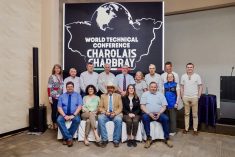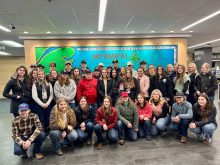Although nutritional and carcass quality research exists on grass-fed production systems, why aren’t there more studies in a Canadian-specific context?
The answer, according to one of Canada’s top ruminant nutrition researchers, lies in the number of variables involved in these studies, including our northern climate.
“From the perspective of a scientist, it’s much more difficult to do work in grass-based systems than it is in feedlot-based systems because there are many more variables to control,” says Dr. Tim McAllister, principal research scientist in ruminant nutrition and microbiology at Agriculture and Agri-Food Canada’s Lethbridge Research and Development Centre
Read Also

Growing Canada’s beef herd: CCA’s priorities working with new federal government
This is my first column since the federal election. The Canadian Cattle Association works with all elected officials and parliamentarians, regardless…
For example, when conducting research on a feedlot-based production system, it’s easier to control the variables in what each animal is being fed.
“If you mix up a (total mixed ration) we can have defined ingredients,” says McAllister. “We know exactly what the animal’s being fed, whereas if the animal is grazing that forage is not constant over time. It changes with the season, and so that’s an important differentiation.”
Sound research, McAllister explained, also requires multiple years of work to provide a better understanding of the environmental factors that may be at play within a system and to consider those factors in the findings.
“It depends on the complexity of the pasture,” he says, noting that this can vary based on the production system used in a certain country.
“New Zealand is probably the most advanced grazing system in the world, definitely in terms of dairy production,” he says. “But they have a pretty uniform pasture because it’s primarily a rye grass-based pasture, so it’s not mixed pastures like we would typically have in our native grazing systems.”
As well, many tame pastures are also a mixture of species rather than a monoculture. “So all those things make it more complicated to do grassland-based research.”
Another challenge in the Canadian context, when compared to grass-based research in other countries, is our winters.
“We don’t do a lot of grassland research in the middle of winter because we’re feeding cows in confinement,” says McAllister. “If you wanted to look at competitiveness of Canadian grassland-based production systems relative to other regions in the world, it’s really just winter that puts us at a big disadvantage.”
While countries with advanced grazing systems such as New Zealand have conditions that allow for year-round grazing, that proves difficult in Canadian winters.
“We do things like stockpiling and there is some winter grazing that’s done in the south, but at that point you’re grazing very low-quality forage because it’s reached maturity and it’s not as digestible as what you’d be dealing with in some of those other countries.”
The conversation on grass-fed beef and the challenges and opportunities in raising cattle through this production system has gained more attention with producers due to programs such as A&W’s 100 per cent Canadian grass-fed beef initiative, announced earlier this year.
McAllister sees room for more research within this space as related to breeding forage varieties for improved digestibility, as well as examining greater use of legumes in forage mixtures.
“We still have the problem with alfalfa causing bloat. There’s quite a desire to include legumes in pastures because of their nitrogen-fixing capacity, so definitely in forage breeding and the relationship between seasonal development of the plant and the quality of the forage, those are areas where there needs to be more research.
A major area of study in this field that McAllister is currently involved with himself is on the larger scope of grassland ecosystems in Canadian beef production. Those grassland ecosystems are important because “many of the most vulnerable species at risk exist in those native grasslands.”
“Native grasslands of North America are actually one of the most threatened ecosystems there are on the earth,” he adds.
“We always hear about people chopping down the (Amazon) rainforest. Well, if you look at a percentage damage of area, if you compare the rainforest to the North American grasslands, we’ve destroyed more of the North American grasslands than they have of the rainforest.”
For more on the ongoing discussion about the role of grass-fed beef production systems in Canada and its challenges and opportunities, see the August issue of Canadian Cattlemen.

















